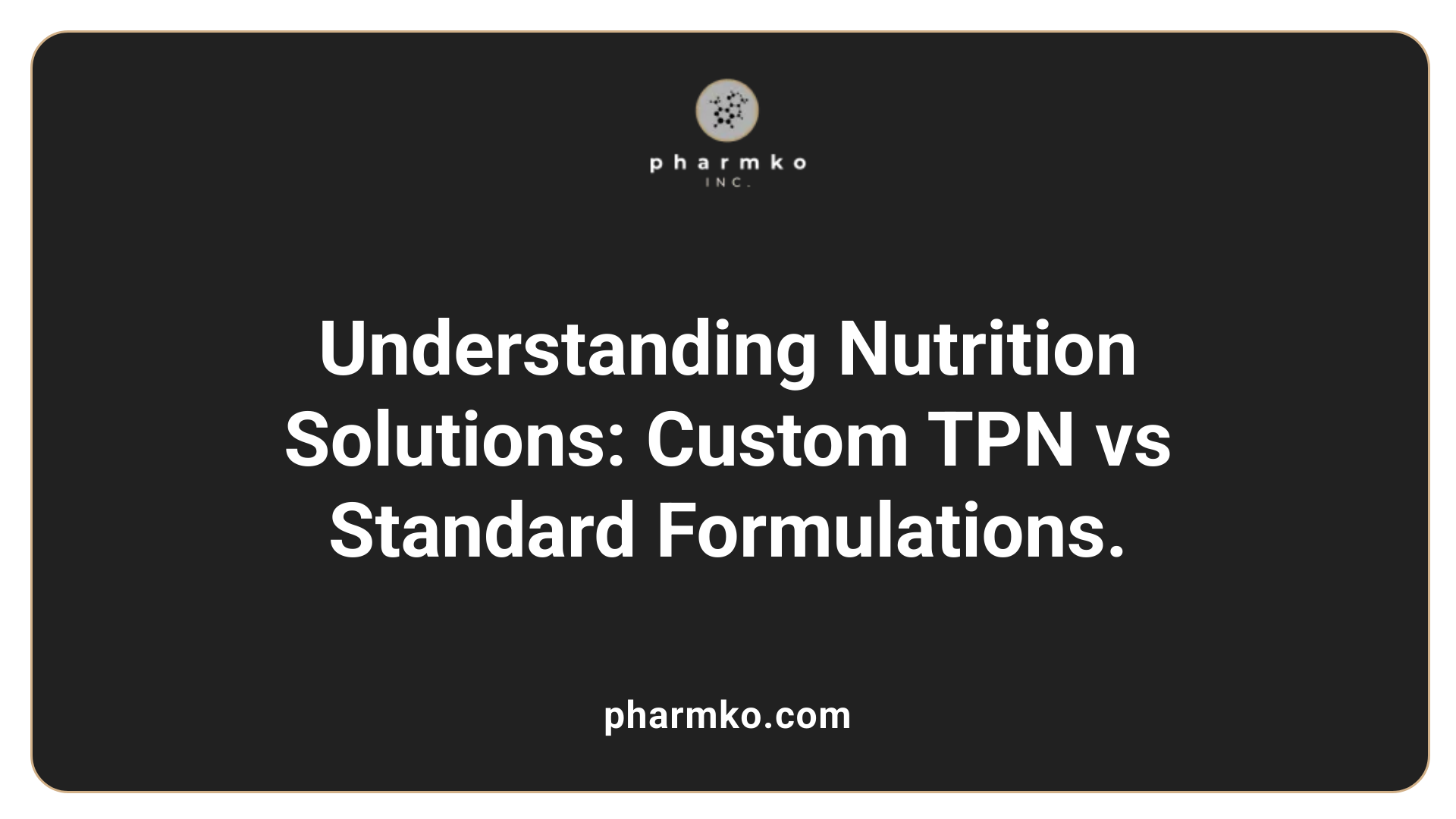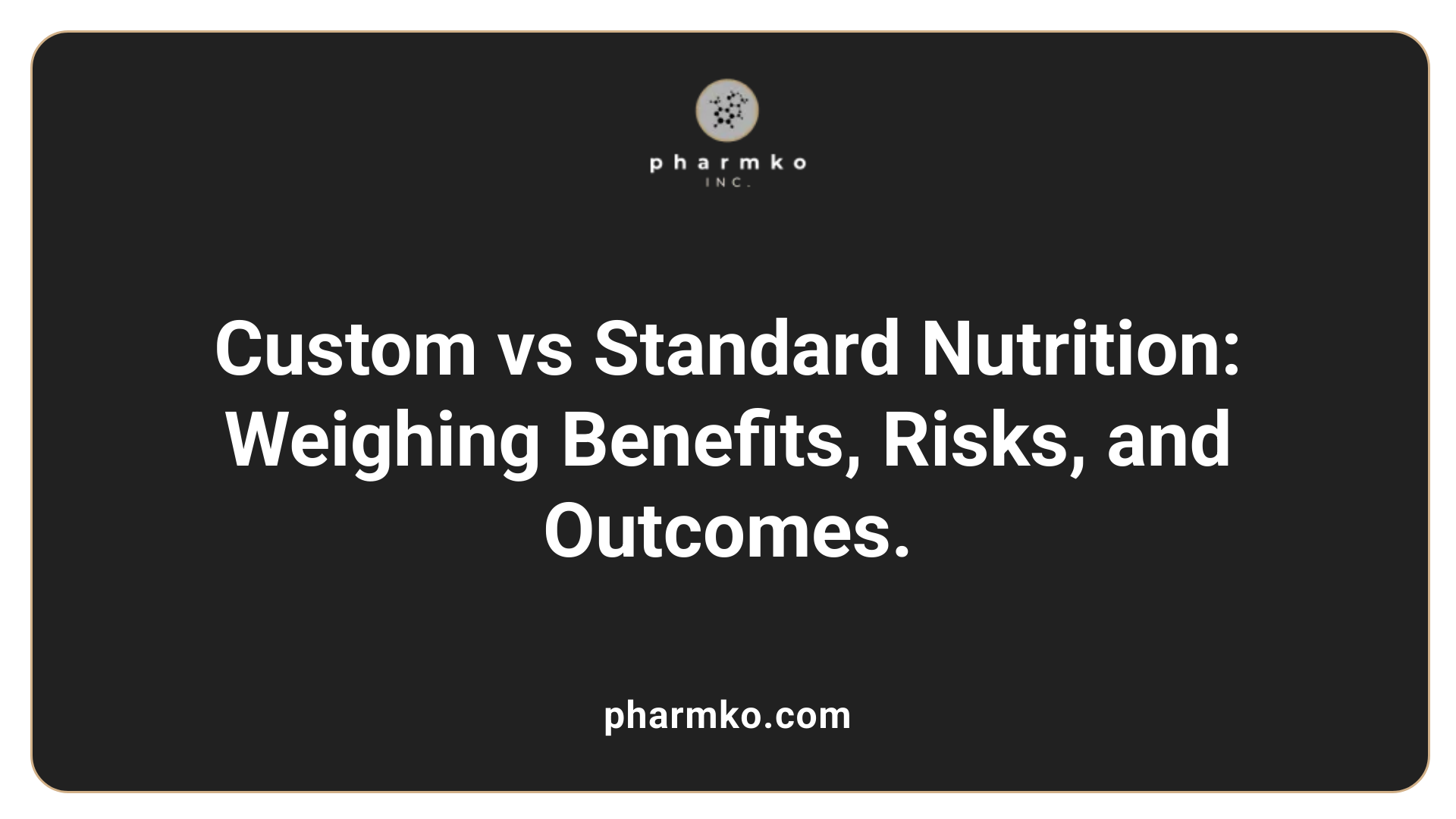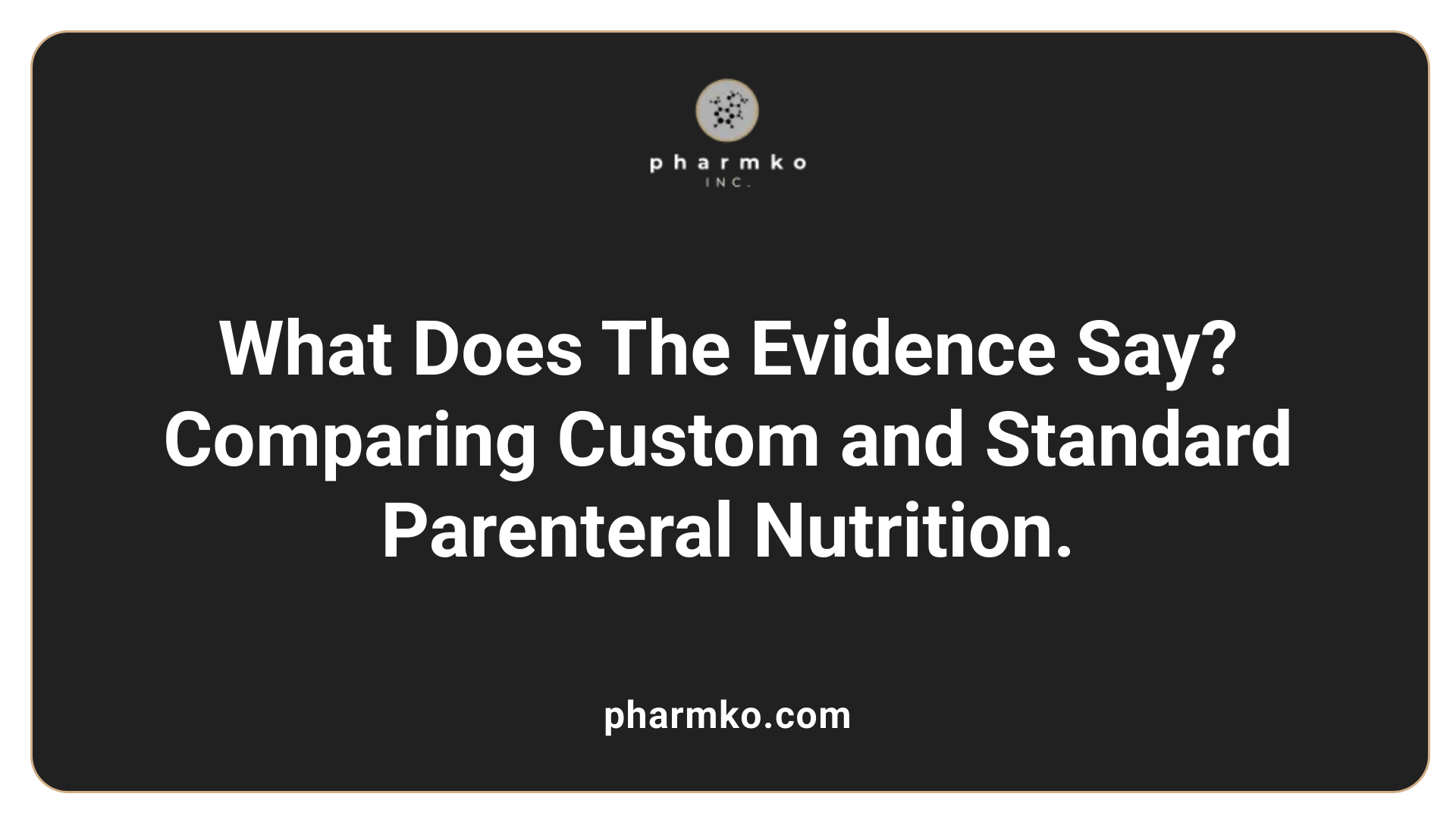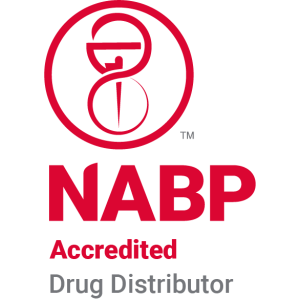Custom TPN vs standard nutrition
Understanding the Landscape of Parenteral Nutrition
In clinical nutrition, the choice between custom total parenteral nutrition (TPN) and standardized formulations is pivotal. Both approaches aim to meet individual patient needs, but their differences in composition, application, safety, and cost influence clinical decisions. This article explores the comparative effectiveness, benefits, drawbacks, and clinical considerations of custom TPN versus standard nutrition solutions, informed by recent research and expert analysis.
Differences Between Custom TPN and Standard Nutrition Formulations
What are the differences between custom TPN and standard nutrition formulations?
Custom total parenteral nutrition (TPN) solutions are specifically prepared to meet each patient's unique nutritional needs. This process involves a healthcare provider working with a pharmacy to tailor the composition, adjusting macronutrients like amino acids, dextrose, and lipids, as well as electrolytes, vitamins, and minerals based on the patient’s lab results and clinical condition. Custom formulations are flexible, allowing the medical team to modify the nutrient levels over time to optimize patient care.
In contrast, standardized nutrition formulations are pre-made solutions available in fixed concentrations. Known as premixed or multi-chamber bags, these are commercially produced and dispensed directly by pharmacies. They are designed to meet general nutritional needs for most patients, providing a quick and convenient option.
While both approaches aim to ensure patients meet their caloric and nutrient requirements, research indicates that standardized PN solutions can match custom TPN in achieving calorie goals. However, they may fall short in providing sufficient protein in some cases and are associated with a higher likelihood of hyponatremia, a condition marked by low sodium levels. Importantly, standardized solutions typically reduce pharmacy preparation time—averaging around 20 minutes compared to 80 minutes for custom solutions—and may lead to cost savings, especially in settings where large volumes are used.
Overall, the choice between custom and standard PN depends on individual patient needs, resource availability, and clinical judgment. In many situations, standardized solutions offer an effective, safe, and economical option, providing adequate nutrition while streamlining preparation and reducing errors.
Composition and Customization of TPN Versus Standard Nutrition Solutions
 Total parenteral nutrition (TPN) solutions are carefully tailored to meet each patient's unique nutritional needs. These solutions typically contain carbohydrates, proteins, fats, electrolytes, vitamins, and minerals. The exact composition is determined based on comprehensive lab assessments, including blood tests that analyze electrolytes, organ function, and nutritional status. This data guides healthcare providers in customizing the formulation, which involves adjusting the ratios and doses of nutrients to optimize metabolic balance and support recovery.
Total parenteral nutrition (TPN) solutions are carefully tailored to meet each patient's unique nutritional needs. These solutions typically contain carbohydrates, proteins, fats, electrolytes, vitamins, and minerals. The exact composition is determined based on comprehensive lab assessments, including blood tests that analyze electrolytes, organ function, and nutritional status. This data guides healthcare providers in customizing the formulation, which involves adjusting the ratios and doses of nutrients to optimize metabolic balance and support recovery.
In contrast, standard nutrition formulas—such as premixed solutions like Clinimix—are pre-made with fixed nutrient ratios. They are designed to serve the general needs of patients who require nutritional support but do not need individualized modifications. These formulas are available in specific concentrations and formulations, such as 8/14 or 6/5 amino acids and dextrose percentages, providing a straightforward alternative to customized solutions.
The customization process for TPN includes several steps:
- Collecting and analyzing patient lab data
- Calculating the precise amounts of each nutrient needed
- Preparing the formulation, often in a hospital pharmacy
- Reassessing regularly and modifying the solution as the patient's condition evolves
This tailored approach offers several advantages. It allows for precise control of electrolyte and micronutrient levels, reduces the risk of metabolic complications, and can better address complex or chronic nutritional deficiencies. However, it requires more time, expertise, and resources.
Standard solutions, while less flexible, provide benefits in terms of faster preparation, reduced formulation errors, and cost savings. They are especially useful in short-term or less complex cases where rapid nutritional support is necessary.
Overall, the choice between customized TPN and standard formulas depends on the patient's specific medical condition, ongoing nutritional requirements, and resource availability.
Clinical Situations Favoring Custom TPN Over Standard Nutrition

In what medical situations is custom TPN preferred over standard nutrition, and what patient considerations influence this choice?
Custom total parenteral nutrition (TPN) is generally favored when patients have complex medical needs that cannot be adequately met with standardized solutions. For example, in cases involving significant gastrointestinal dysfunction—such as short bowel syndrome, malabsorption, or congenital malformations—custom TPN offers the flexibility to tailor nutrient components precisely to the patient’s needs.
Patients suffering from severe conditions that require long-term nutritional support, like chronic malnutrition, high-output fistulas, or extensive burns or trauma, often benefit from individualized TPN. These conditions often demand specific amino acid profiles, electrolyte balances, or lipid formulations that standard solutions may not adequately provide.
The choice of custom TPN is also influenced by several patient-specific factors. The extent of intestinal function determines whether enteral feeding is possible or whether exclusive Parenteral Nutrition is necessary. Metabolic stability, risk of complications, and vascular access options play roles in decision-making.
Furthermore, in critically ill or unstable patients, custom formulations allow healthcare providers to adjust nutrient delivery based on ongoing assessments of metabolic demands and laboratory results. This precise tailoring helps mitigate risks like electrolyte imbalances, hepatic dysfunction, or metabolic derangements.
Overall, a careful evaluation by a multidisciplinary team—including physicians, dietitians, and pharmacists—is crucial to determine when custom TPN is appropriate. The goal is to maximize nutritional benefits while minimizing potential risks, ensuring the best possible outcomes for patients with complex or unique needs.
Benefits, Drawbacks, and Clinical Effectiveness of Custom TPN vs Standard Nutrition

What are the benefits and drawbacks of using custom TPN compared to standard nutritional approaches?
Custom total parenteral nutrition (TPN) provides the advantage of tailoring a patient's nutritional formulation to meet specific clinical and metabolic needs. This customization allows for precise adjustments in electrolytes, amino acids, lipids, and micronutrients, which is particularly beneficial in complex medical conditions or long-term nutritional support. Such individualized care can lead to improved clinical outcomes, especially in cases involving severe bowel issues or critical illness.
However, the process of preparing custom TPN is complex, requiring meticulous formulation, careful monitoring, and specialized expertise. This increases the chance of errors, infections, or nutrient imbalances if not managed properly. Additionally, custom solutions typically involve higher costs and longer preparation times compared to standardized options.
Standardized TPN solutions, such as Clinimix, offer ready-made, consistent formulations which reduce preparation time, lower the risk of compounding errors, and usually cost less in terms of preparation resources. These are suitable for patients with less complex needs or those requiring short-term nutrition. The choice between custom and standard TPN involves weighing the benefits of precise, individualized nutrition against the safety, efficiency, and cost-effectiveness of ready-made solutions.
What are the clinical outcomes and effectiveness of using custom TPN compared to standard nutritional approaches?
Studies indicate that custom TPN might provide superior results in achieving adequate protein intake and supporting complex nutritional demands. For instance, patients on custom TPN tend to meet higher protein targets (92%) compared to those on standardized PN (63%), which may translate into better overall nutritional status.
In addition, research shows that standardized PN solutions are associated with a higher rate of hyponatremia (37% vs 14%), highlighting potential safety considerations.
In terms of broader clinical outcomes, a retrospective review found no significant differences between the two approaches in achieving caloric goals or reducing hospital and ICU stay durations. This suggests that standardized solutions can be as effective as custom formulations for certain outcomes. Early intervention with parenteral nutrition has also been shown to reduce infections and support faster recovery.
Cost-wise, standardized PN can provide savings—about $130 per bag—by simplifying preparation and reducing errors. Nonetheless, for patients with complicated or specific needs, a customized approach can offer improved nutritional adequacy, ultimately supporting better recovery and health outcomes.
Research Evidence and Systematic Reviews Comparing Approaches
 Various studies and reviews have analyzed the differences between customized total parenteral nutrition (TPN) and standardized nutritional approaches.
Various studies and reviews have analyzed the differences between customized total parenteral nutrition (TPN) and standardized nutritional approaches.
Research indicates that personalized TPN formulations offer benefits in specific patient groups, particularly those with complex needs requiring precise nutrient adjustments. For example, customized TPN can optimize fluid management and electrolyte balance, which is crucial for malnourished or fluid-sensitive patients.
Systematic reviews show that both TPN and partial parenteral nutrition (PPN) are generally safe for chronically ill ICU patients, with no significant differences observed in patient mortality or key laboratory indicators of nutritional status. This suggests that the choice of approach can be tailored based on individual patient requirements rather than safety concerns alone.
Another body of evidence compares parenteral nutrition to enteral feeding methods such as tube feeding. Studies demonstrate that enteral nutrition is associated with lower infection risks, shorter hospital stays, and better gut integrity, favoring its use whenever possible.
Cost analyses also support the use of standardized solutions in suitable cases, citing reductions in pharmacy preparation time and overall expenses—sometimes around $130 per bag—without compromising caloric delivery.
In summary, evidence supports a nuanced approach: highly tailored TPN may benefit patients with complex metabolic needs, while standardized solutions are effective and resource-efficient for less complicated cases. This knowledge helps clinicians optimize nutrition strategies to improve outcomes and reduce healthcare costs.
Choosing the Optimal Nutritional Strategy
The decision between utilizing custom TPN or standard nutrition solutions hinges on individual patient needs, clinical circumstances, and resource availability. While bespoke TPN offers unparalleled precision for complex cases demanding tailored nutritional support, standardized formulations provide a safe, efficient, and cost-effective alternative for many patients. Emerging evidence underscores that in suitable scenarios, standardized solutions like Clinimix can achieve comparable caloric goals and reduce preparation time, especially when high protein intake or specific electrolyte management are not critical. Ultimately, comprehensive assessment by multidisciplinary teams, continuous monitoring, and adaptive treatment plans are essential to optimize nutritional outcomes and patient safety. Advances in parenteral nutrition strategies continue to evolve, promising better tailored care and resource utilization across diverse clinical settings.
References
- Standardized versus custom parenteral nutrition: impact on clinical ...
- Clinimix vs. TPN: How Are They Different?
- A Comparison Between Customized and Premixed Parenteral ...
- Standardized versus custom parenteral nutrition: Impact on clinical ...
- Commercial Premixed Parenteral Nutrition and Its Potential Role in ...
- [PDF] Reducing Custom TPN Orders Via Utilization of Evidence
- Home Total Parenteral Nutrition (Home TPN) - Nutrishare
- [PDF] The Hitchhiker's Guide to Parenteral Nutrition Management for Adult ...













